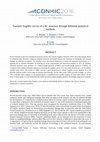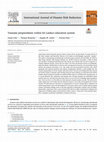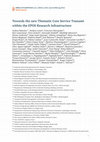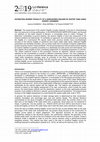Papers by Tiziana Rossetto

The widespread damage caused by past tsunami, e.g. 2004 Indian Ocean Tsunami and 2011 Great East ... more The widespread damage caused by past tsunami, e.g. 2004 Indian Ocean Tsunami and 2011 Great East Japan tsunami, has motivated several research activities in tsunami engineering. The behaviour of buildings subjected to tsunami actions has received particular attention. Some studies have been published regarding the estimation of tsunami action; many papers, as well as existing building codes suggest modelling the tsunami-structure interaction with an equivalent force approach. These literature papers propose that the tsunami force and its distribution along the height of the structure are strictly related to the features of the tsunami flow, e.g. flow velocity and inundation depth. However, there is a lack of published literature concerning the analysis methodologies to adopt for estimating the response of buildings to these tsunami loads. A question therefore arises as to which analysis method is the most appropriate in the case of tsunami inundation of buildings and whether the nonlinear static analysis method, commonly used in earthquake engineering, is suitable for this case. This paper presents a study aimed at shedding light on analysing buildings subjected to actions due to tsunami inundation. In particular, three different analysis methodologies of constant-height pushover (CHPO), variable-height pushover (VHPO), and time-history (TH) analyses are compared in terms of their abilities to predict structural response. An existing 10-storey reinforced concrete tsunami evacuation building in Japan is considered as case study. A distributed plasticity approach is adopted to model the RC frame structure. Two different load patterns, i.e. triangular and trapezoidal, are adopted to distribute the tsunami force along the height of the structure. The two pushover analysis methodologies, i.e. CHPO and VHPO, are compared to TH analysis in terms of their abilities to predict structural response for an extensive set of simulated tsunami inundation time-histories. It is found that the results of VHPO provide a good prediction of the engineering demand parameters obtained from the TH analysis under a wide range of tsunami time-histories. CHPO gives a worse prediction of the demand; it overestimates interstorey drift ratio and underestimates column shear by about 5-20%. It is concluded that pushover methods are a good proxy for TH. In particular, it is recommended that VHPO be used in future analysis of buildings subjected to tsunami. It should be also highlighted that pushover methods may be inadequate in cases where the tsunami inundation force time-history is characterised by a double-peak, which subjects the structure to a twocycle load.

Recent tsunami events have stimulated research activity into tsunami fragility functions which ha... more Recent tsunami events have stimulated research activity into tsunami fragility functions which have been largely based on empirical data. However, empirical fragility functions are biased because the influence of earthquake and tsunami damage are difficult to separate. We develop a new theoretical framework to assess the structural performance of a building due to tsunami inundation by drawing on recent experimental and theoretical progress at UCL on building. Different nonlinear static analyses, i.e. constant-height pushover (CHPO) and variable-height pushover (VHPO), are compared with nonlinear dynamic analysis in assessing the fragility curves of a case study structure for a set of realistic tsunami wave traces. The results of VHPO provide a good prediction of collapse fragility curves obtained from the dynamic analysis under a wide range of tsunami time-histories. On the other hand, CHPO provides a larger, i.e. about 10% in median value, fragility in case global failure is considered and a smaller fragility for local shear failure. On the basis of these results, it is recommended that VHPO be used in future fragility analysis of buildings subjected to tsunami.
Frontiers in Built Environment, Feb 16, 2018
Editorial on the Research Topic Mega Quakes: Cascading Earthquake Hazards and Compounding Risks a... more Editorial on the Research Topic Mega Quakes: Cascading Earthquake Hazards and Compounding Risks aUtHor CoNtriBUtioNS KG, TR, NM, and ST handled manuscripts and edited the Research Topic.
Stochastic Environmental Research and Risk Assessment, Nov 12, 2016

Frontiers research topics, 2018
Large-scale earthquake hazards pose major threats to modern society, generating casualties, disru... more Large-scale earthquake hazards pose major threats to modern society, generating casualties, disrupting socioeconomic activities, and causing enormous economic loss across the world. Events, such as the 2004 Indian Ocean tsunami and the 2011 Tohoku earthquake, highlighted the vulnerability of urban cities to catastrophic earthquakes. Accurate assessment of earthquake-related hazards (both primary and secondary) is essential to mitigate and control disaster risk exposure effectively. To date, various approaches and tools have been developed in different disciplines. However, they are fragmented over a number of research disciplines and underlying assumptions are often inconsistent. Our society and infrastructure are subjected to multiple types of cascading earthquake hazards; therefore, integrated hazard assessment and risk management strategy is needed for mitigating potential consequences due to multi-hazards. Moreover, uncertainty modeling and its impact on hazard prediction and anticipated consequences are essential parts of probabilistic earthquake hazard and risk assessment. The Research Topic is focused upon modeling and impact assessment of cascading earthquake hazards, including mainshock ground shaking, aftershock, tsunami, liquefaction, and landslide

Frontiers in Built Environment, Jun 11, 2021
This paper describes the evolution through three generations of pneumatic Tsunami Simulators for ... more This paper describes the evolution through three generations of pneumatic Tsunami Simulators for physical model tests of realistic tsunami. The pneumatic method, originally developed for tidal modeling in the Fifties, has been modernized to generate extraordinarily long waves in a controlled manner, with accurate reproduction of recorded free-surface tsunami field data. The paper describes how the simulator designs were developed and how they performed in the laboratory. Example results are presented from selected research studies that have validated their performance and then used to quantify tsunami effects. Having described each of the first, second, and third generation Tsunami Simulators, the paper discusses how to calibrate the wave generation control to model tsunami with model periods 20-240 s duration (equivalent to 2-20 min duration in prototype at 1:50 scale), many of which are far too long to "fit into the test flume." The evolution of a composite approach to wave calibration is described with examples from second and third generation devices, demonstrated by successful simulation of both the 2004 Boxing Day, and the 2011 Great Eastern Japan (Tohoku) Tsunami at 1:50 scale.
Engineering Structures, Apr 1, 2017

SSRN Electronic Journal
Asked what hazard posed the greatest threat to their school, the principals of coastal schools in... more Asked what hazard posed the greatest threat to their school, the principals of coastal schools in the Galle, Ampara and Batticaloa districts of Sri Lanka overwhelmingly responded "tsunami". This result is unsurprising considering the scale and trauma caused by the December 26, 2004 Indian Ocean tsunami. This tsunami claimed over 35,000 victims in Sri Lanka, a third of whom were children. It damaged and destroyed 182 schools, and a further 287 served as camps for internally displaced persons. Given that Sri Lanka is far from all potential sources of earthquakeinduced tsunami, and that there is time for early warning and evacuation, it is crucial that coastal schools are prepared and ready to act. This study uses semi-structured interviews with school principals and regional education and disaster management officials to gain insights into the tsunami preparedness of the Sri Lankan education sector. Overall, our findings show that schools are heavily reliant on tsunami early warning towers for their warning, yet only half of the 430 Sri Lankan schools exposed to tsunami are within audible range of a tsunami early warning tower. It is crucial therefore that alternative and backup early warning channels are established where needed. However, the interviews show that there is a very low level of baseline hazard preparedness. There are few or no fire drills, let alone tsunami evacuation plans or drills. The school principals express the view clearly that the education system in Sri Lanka is ill-prepared for a future tsunami. We find however that there are opportunities to involve existing safety committees in school preparedness and in the development of evacuation plans; and to exploit existing regular teacher curriculum training events to develop capacities in emergency response and evacuation. Importantly, experiences from a past tsunami drill with Sri Lankan communities emphasise the importance of holding regular school practice drills as well as "end-to-end" (from tsunami detection to tsunami evacuation) community evacuation exercises.

The 2004 Indian Ocean tsunami inflicted more than 35 ,000 casualties in Sri Lanka, a third of who... more The 2004 Indian Ocean tsunami inflicted more than 35 ,000 casualties in Sri Lanka, a third of whom were children. It affected 5% of the country’s schools, severely damaging 108 and destroying 74. The catastrophe highlighted the critical role of schools in providing educational continuity and shelter during community recovery. Sri Lanka has since rehabilitated and rebuilt most of the destroyed schools along the coastline. However, there is a limited understanding of current levels of school exposure to tsunami. This limited understanding hampers preparedness and risk reduction interventions that can improve community and educational resilience to future tsunami. This paper presents a multi-disciplinary school exposure database relevant to both vulnerability and loss modelling. The repository includes data on 38 school and 85 classroom buildings, surveyed across the coastal districts of Ampara, Batticaloa and Galle in Sri Lanka, which were heavily affected by the 2004 tsunami. A new e...

Frontiers in Built Environment
This paper describes the evolution through three generations of pneumatic Tsunami Simulators for ... more This paper describes the evolution through three generations of pneumatic Tsunami Simulators for physical model tests of realistic tsunami. The pneumatic method, originally developed for tidal modeling in the Fifties, has been modernized to generate extraordinarily long waves in a controlled manner, with accurate reproduction of recorded free-surface tsunami field data. The paper describes how the simulator designs were developed and how they performed in the laboratory. Example results are presented from selected research studies that have validated their performance and then used to quantify tsunami effects. Having described each of the first, second, and third generation Tsunami Simulators, the paper discusses how to calibrate the wave generation control to model tsunami with model periods 20–240 s duration (equivalent to 2–20 min duration in prototype at 1:50 scale), many of which are far too long to “fit into the test flume.” The evolution of a composite approach to wave calibr...

Annals of Geophysics
Tsunamis constitute a significant hazard for European coastal populations, and the impact of tsun... more Tsunamis constitute a significant hazard for European coastal populations, and the impact of tsunami events worldwide can extend well beyond the coastal regions directly affected. Understanding the complex mechanisms of tsunami generation, propagation, and inundation, as well as managing the tsunami risk, requires multidisciplinary research and infrastructures that cross national boundaries. Recent decades have seen both great advances in tsunami science and consolidation of the European tsunami research community. A recurring theme has been the need for a sustainable platform for coordinated tsunami community activities and a hub for tsunami services. Following about three years of preparation, in July 2021, the European tsunami community attained the status of Candidate Thematic Core Service (cTCS) within the European Plate Observing System (EPOS) Research Infrastructure. Within a transition period of three years, the Tsunami candidate TCS is anticipated to develop into a fully op...

Currently available performance-based methodologies for assessing the fragility of structures sub... more Currently available performance-based methodologies for assessing the fragility of structures subjected to tsunami neglect the effects of tsunami-induced vertical loads due to internal buoyancy. This paper adopts a generalized methodology for the performance assessment of structures that integrates the effects of buoyancy loads on slabs during a tsunami inundation. The methodology is applied in the fragility assessment of three case-study frames (low, mid and high-rise), representative of existing masonry-infilled reinforced concrete (RC) buildings typical of Mediterranean region. The paper shows the effect of modelling buoyancy loads on damage evolution, structural performance and fragility curves associated with different structural damage mechanisms for RC frames with breakaway infill walls including consideration of blow-out slabs. The outcomes attest that the predominant failure mechanism of selected case-study is the brittle shear failure of seaward columns, which is slightly ...

The assessment of the seismic fragility of water networks is the key to characterizing their risk... more The assessment of the seismic fragility of water networks is the key to characterizing their risk exposure to strong earthquakes. In the HORIZON2020 IMPROVER project, we focused our attention on the water network of Barreiro, a municipality close to Lisbon, Portugal. To determine vulnerability to ground shaking, the seismic fragility of each key component of the network needed to be determined. To exemplify our approach, we concentrate here on assessing the fragility of a semi-buried RC square water tank; previous studies have overwhelmingly focused on the seismic fragility of cylindrical (and mainly steel) water tanks. Relevant fragility parameters are inevitably uncertain, and our study made use of a sample of experts’ judgements, pooled using the Cooke’s Classical Model. This structured approach derives performance weights for experts’ abilities to quantify uncertainty in a statistically accurate sense and informatively, and then applies these weights to their uncertainty judgeme...

The increasing number of people, structures and economic activities being exposed to tsunami haza... more The increasing number of people, structures and economic activities being exposed to tsunami hazards makes it important to estimate the effects of this hazard on coastal developments. Tsunami onshore flow generates significant loading on buildings and infrastructure, which can lead to structural failure. Literature works recently proposed a non-linear static analysis method, called Variable Depth Pushover (VDPO), for assessing the performance of buildings under the lateral pressures induced by a tsunami onshore flow. This methodology was developed under the assumption that the building is watertight. However, in the case of buildings with breakaway cladding (e.g., masonry infills), the water flow passing through the building induces vertical loads on horizontal structural members, due to uplift and buoyancy pressures, that should be considered during the analysis. Thus, to address this phenomenon, in this paper a numerical investigation is performed considering a combination of tsun...

Tsunami design provisions for coastal structures are now included in a new chapter of ASCE 7-16 S... more Tsunami design provisions for coastal structures are now included in a new chapter of ASCE 7-16 Standard. The provisions provide prescriptive tsunami loading and design requirements, and they allow for the use of alternative performance-based criteria, including nonlinear static analysis. However, no guidance is provided as to how the performance-based analysis should be performed. This paper presents an improved nonlinear static pushover procedure for the assessment of the nonlinear capacity of structures to tsunami, within the framework of the ASCE 7-16 provisions. For this purpose, a prototypical reinforced concrete multi-storey building exposed to high seismic and tsunami hazards along the Northwest Pacific coast of the USA is assessed. Two different tsunami load discretisation methods are applied to investigate the structural capacity under tsunami systemic and component loading, respectively. The results of the nonlinear static pushover analyses show that the structural system...
Engineering Structures, 2021
Uploads
Papers by Tiziana Rossetto